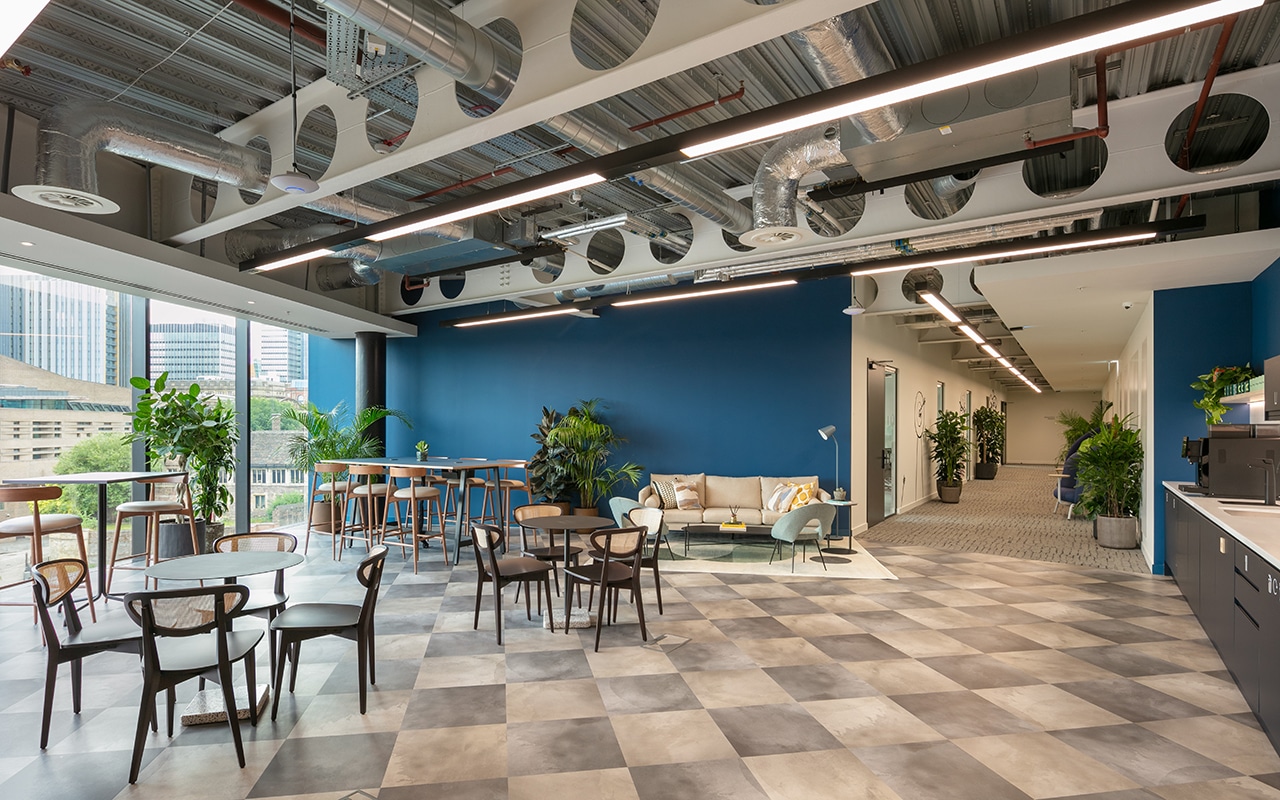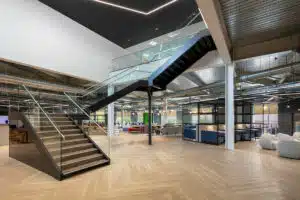In recent years, legal policy and attitudes towards diversity and inclusion in the workplace have undergone a significant shift. Many companies are making conscious efforts to educate their teams, create a more diverse work culture, and make their offices more accessible and welcoming for marginalised groups. However, all too often, their office designs are letting them down.
To truly accommodate a more diverse workforce, companies need to create inclusive offices, ensuring that they’re suitable for a range of people, regardless of their needs, preferences or abilities. While it’s important to recognise that everybody is different, the focus shouldn’t be on catering for every single possible need. It should be on levelling the playing field, incorporating choice and flexibility, and considering diversity in office design to create an environment where all employees can succeed.
Inclusion in the workplace is not only vital from a moral standpoint, but companies at more advanced stages of their DEI journeys typically reap performance and productivity benefits, as well as increased employee retention, and easier recruitment.
What is diversity and inclusion in workplace design?
While most discussions about inclusion in the workplace revolve around company culture and policies, the office design plays a key role in bringing down physical barriers to provide equal opportunity and access.
Equality, diversity and inclusion in office design refers to creating workspaces that embrace and support the unique needs, perspectives, and backgrounds of all employees. This could be those with disabilities and neurodiverse conditions, as well as people with differing ethnicities, sexual orientations or gender identities. While inclusive workplaces should cater for these different needs and preferences, it’s also important to be mindful that efforts don’t segregate any employees.
What are the benefits of designing for inclusivity and accessibility in the workplace?
As well fulfilling a duty of care to all employees, there are so many benefits of equality and diversity in the workplace. It’s no secret that employees are more likely to be satisfied and productive on the job when they’re working in an environment that supports their needs and fosters a sense of belonging. In fact, research shows that organisations in the top quartiles for ethnic and gender diversity are more likely to outperform financially.
Diverse employment also encourages creativity and innovation, bringing together a broader range of ideas, perspectives and experiences. ESG and AWS data found that 63% of organisations leading in DEI said their efforts extensively, positively impacted agility and innovativeness. Those organisations also saw positive effects on brand perception (68%) and recruitment and retention (64%).
Equality, diversity and inclusion at work is becoming an increasingly important factor for employees, with many studies showing that Gen Z workers look for a strong commitment to DEI and company values that align with their own when choosing an employer.
Top tips for inclusive and accessible office design
Workplace designs for accessibility
Designing for accessibility is all about removing physical barriers to entry and inclusion, and accommodating people with specific needs, disabilities and impairments. It’s important to be mindful that disability is on a broad spectrum, and while some are physically apparent, others are not visible.
Equal access for all is a legal requirement in the modern workplace, as outlined by The Disability Discrimination Act and the Equality Act 2010, which identifies nine protected characteristics and details the ‘reasonable adjustments’ employers and service providers must make to accommodate individuals with disabilities.
Despite this, the Business Disability Forum found that disabled employees have to wait too long for reasonable adjustments to be made, with some having to push for these adjustments or even fund them themselves. Businesses should be proactive in taking steps to make their workplace accessible. Key considerations include:
- Ensuring users of wheelchairs and mobility equipment can move around the building easily. Provide ramps and lifts wherever necessary, and ensure there are wide passing spaces, ideally the width of two wheelchairs, to allow enough room for disabled employees to comfortably move around and pass others without difficulty.
- Making sure disabled employees can work comfortably and access key amenities. Height-adjustable desks, ideally with centred legs to allow ample knee space, are useful for employees using mobility devices. Power sockets and light switches should be within comfortable reaching distance, as should storage solutions.
- Considering sensor-activated doors, bins and taps for ease, and ensuring that door handles are accessible for employees with limited manual dexterity.
- Introducing braille and large print signage to help employees with visual impairments. Symbols and numbers are usually most effective for those with visual impairments and neurological disabilities.
- Using different textures or colours on walls and surfaces to draw attention to obstacles and changes in elevation.
Workplace designs for inclusivity
Inclusive workplace design is different to designing for accessibility, as it recognises a broader spectrum of needs and preferences, and takes into account characteristics like age, gender, culture, sexual orientation and socioeconomic background. The focus here should be on creating spaces to help all employees feel accepted, comfortable and able to perform. Things to think about include:
- Providing ergonomic furniture and equipment to accommodate a diverse range of body types.
- Introducing agile settings or hot desking areas. This can be effective to encourage collaboration and communication between employees that wouldn’t usually work or socialise together and can help to bring down internal barriers between more senior and junior team members. However, this way of working may not be comfortable for everyone, particularly employees who may be more used to having their own space.
- Providing prayer rooms for different religions so employees can practice their faith in a dedicated environment.
- Introducing non-binary toilets to reduce stigma and help employees feel safe and respected regardless of gender identity.
- Offering a mothers’ room, to allow feeding mothers a comfortable and safe space to express breast milk, to help them support their baby’s needs and continue breast feeding after returning to work.
- Providing baby changing facilities and an on-site creche or nursery if feasible, to support working parents.
Workplace designs for neurodiversity
Office design has the ability to significantly support or hinder those with neurodiverse conditions. Here we cover some basic considerations for how businesses can acknowledge different learning styles and ways of thinking. We explore this topic further in our dedicated blog on office design for wellbeing.
- Offer a variety of workplace settings – recognising and accommodating different work styles and preferences is increasingly important. Give people more autonomy in how and where they work through a range of workplace settings (areas for focused work, collaboration spaces, quiet zones, meeting rooms etc.) and recognise that preferences may change depending on the task they’re doing or how they’re feeling at the time.
- Consider how sound travels. Not only are noisy or distracting work environments not conducive to productivity, but these conditions can induce stress for some people. Use acoustic panelling, carpets and soft furnishings to help reduce noise transmission and consider introducing quiet rooms, focus zones or private pods, to support deep work and concentration.
- Think about lighting. Natural light is important for focus and wellbeing, and studies have shown it can be an important factor in helping neurodivergent employees perform too. If your office space lacks access to natural light, consider introducing lighting solutions to mimic and supplement it.
- Introduce elements of biophilic design to help employees feel more relaxed and peaceful in the working environment, and instil a sense of balance for individuals that are more susceptible to sensory overload.
- Choose your colour palette wisely. Some colours can make people feel tense or anxious, while others are more calming and conducive to focus.
- Offer adjustable and customisable lighting and temperature solutions to allow employees to tailor their environment to their preferences. This can be especially helpful for pregnant or menopausal employees who can experience hot flushes.
Final thoughts
Creating a diverse workplace shouldn’t be an afterthought. It requires active planning, collaboration with employees, and a commitment to continual improvement. Workplace design should place users at the centre and genuinely commit to equality, diversity and inclusion.
While there are lots of important factors to consider and much rides on getting it right, it doesn’t have to be a difficult or overwhelming process. Working with experienced design consultants can help alleviate the pressure and ensure your investment delivers a truly inclusive workplace that empowers employees and helps the business succeed.
Change needn’t be a challenge. For more information, or to start your inclusive office design with guidance from our expert team, get in touch.
FAQs
I want to create a more inclusive workplace – where do I start?
Introduce inclusive design as part of a wider commitment to DEI. Educate employees around inclusivity and diversity, overcoming unconscious bias, and the important role office design plays is ensuring everyone feels safe and supported. When creating an inclusive office design, it is important that employees feel included. Ensure that your design process this shaped by your team’s suggestions and requirements.
How can I measure whether an inclusive workplace design is effective or not?
Conduct surveys to gather feedback from employees about their experiences of the office design, and organise focus groups or one-on-one discussions with employees from different demographics to gain more qualitative feedback. Analysing data on the usage of different areas in the workplace can help to identify key patterns and trends.
How can I ensure my inclusive workplace design remains effective as my business grows and evolves?
Treat inclusivity as an ongoing journey rather than a one-time initiative. After the build or refurbishment, continuously seek opportunities for improvement, gather feedback from employees, and adapt your strategies accordingly to create a more inclusive workplace over time.




